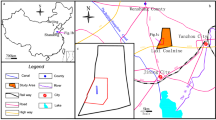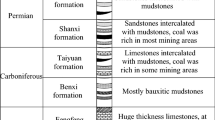Abstract
The use of water from mine dewatering has become increasingly important issue in northern China. Much of this water is discharged to the environment, which wastes a valuable resource and pollutes the ecosystem. To help address this, a feasibility analysis was carried on using deep Ordovician limestone water from dewatering at the Xinglongzhuang coal mine. First, a safe hydraulic pressure was estimated using the conventional water inrush coefficient method. Then, based on the results of a water release test (drilled into an artesian aquifer), a model representing the geology and hydrology of the study area was subsequently established and calibrated to existing conditions and water release test results, using the numerical simulation program FEFLOW. Finally, according to a contract signed between the mine and a local industrial water consumer, two cases of dewatering were discussed using the model to maintain a balance between mining safety and supplying water for nearby industrial operations. During the calibration and prediction analysis, the permeable faults were identified as the most important factor in water management and a key factor for balancing the aforementioned needs.
Zusammenfassung
Die Verwendung von Wasser aus der Entwässerung im Bergbau ist in Nordchina zu einem zunehmend wichtigen Thema geworden. Ein Großteil dieses Wassers wird in die Umwelt abgeleitet, womit eine wertvolle Ressource verschwendet und Ökosysteme verschmutzt werden. Um dieses Thema anzugehen, wurde eine Machbarkeitsstudie zur Nutzung von Wasser aus der Entwässerung eines tiefen ordovizischen Kalksteins im Xinglongzhuang Kohlebergwerk durchgeführt. In einem ersten Schritt wurde unter Verwendung der gebräuchlichen Wassereinbruchskoeffizientenmethode (water inrush coefficient method) ein sicherer hydraulischer Druck abgeschätzt. Anschließend wurde, aufbauend auf den Ergebnissen eines Wasserfreisetzungstests (gebohrt in einem artesischen Aquifer), ein Modell zur Darstellung der Geologie und Hydrologie des Untersuchungsgebiets erstellt und mittels dem numerischen Simulationsprogramm FEFLOW mit aktuellen Bedingungen und Ergebnissen des Wasserfreisetzungstests kalibriert. Abschließend wurden entsprechend eines Vertrages zwischen dem Bergwerksbetreiber und lokalen Abnehmern für Brauchwasser zwei Entwässerungsfälle diskutiert, um unter Verwendung des Modells die Balance zwischen Bergwerkssicherheit und Wasserlieferung für den nahegelegenen Industriebetrieb zu erhalten. Im Zuge der Analyse von Kalibration und Prognose wurden die durchlässigen Störungen als der wichtigste Faktor im Wassermanagement und ein Schlüsselfaktor bei der Abstimmung der o.g. Bedürfnisse identifiziert.
兴隆庄煤矿深部奥陶系灰岩疏排水的合理利用(中国华北)
合理利用煤矿疏放水在中国北方日益重要。煤矿疏放水被大量排放,不但浪费宝贵水资源而且污染生态系统。为解决这一问题,研究了兴隆庄煤矿深部奥陶系石灰岩疏排水的可行性。首先,用传统的突水系数法估算了岩溶水安全疏放水压。然后,基于放水试验(承压含水层钻孔)数据,用FEFLOW建立了研究区地质和水文模型,通过现状条件数据和放水试验结果验证了模型。最后,参考煤矿与当地工业用水用户之间的合同,讨论了两个种既满足煤矿安全开采需要又满足附近工业用水需求的情形。在模型校正和预测过程中,发现导水断层既是水管理的最重要因素也是平衡上述需求的关键因素。
Resumen
El uso de agua de desagote de minas se ha convertido en un problema cada vez más importante en el norte de China. Gran parte de esta agua se descarga al medio ambiente, lo que desperdicia un recurso valioso y contamina el ecosistema. En un abordaje del tema, se realizó un análisis de viabilidad utilizando aguas profundas de piedra caliza de Ordovícico procedentes del desagote en la mina de carbón Xinglongzhuang. En primer lugar, se estimó una presión hidráulica segura utilizando el método convencional de coeficiente de irrupción de agua. Luego, con base en los resultados de una prueba de liberación de agua (perforación en un acuífero artesiano), se estableció un modelo que representa la geología e hidrología del área de estudio; posteriormente, aquel modelo se calibró a las condiciones existentes y a los resultados de la prueba de liberación de agua, utilizando el programa de simulación numérica FEFLOW. Finalmente, de acuerdo con un contrato firmado entre la mina y un consumidor local de agua industrial, se analizaron dos casos de desagote utilizando el modelo para mantener un equilibrio entre la seguridad minera y el suministro de agua para las operaciones industriales de los alrededores. Durante el análisis de calibración y predicción, las fallas permeables se identificaron como el factor más importante en la gestión del agua y un factor clave para equilibrar las necesidades antes mencionadas.









Similar content being viewed by others
References
Abraham MR, Susan TB (2017) Water contamination with heavy metals and trace elements from Kilembe copper mine and tailing sites in Western Uganda: implications for domestic water quality. Chemosphere 169:281–287
Afzal M, Battilani A, Solimando D, Ragab R (2016) Improving water resources management using different irrigation strategies and water qualities: field and modelling study. Agr Water Manage 176:40–54
Bai H, Ma D, Chen Z (2013) Mechanical behavior of groundwater seepage in karst collapse pillars. Eng Geol 164:101–106
Cooper HH, Jacob CE (1946) A generalized graphical method for evaluating formation constants and summarizing well-field history. Eos Trans AGU 27(4):526–534
Dong D, Sun W, Xi S (2012) Optimization of mine drainage capacity using FEFLOW for the no. 14 coal seam of China’s Linnancang coal mine. Mine Water Environ 31:353–360
ElZehairy AA, Lubczynski MW, Gurwin J (2018) Interactions of artificial lakes with groundwater applying an integrated MODFLOW solution. Hydrogeol J 26:109–132
Huang F, Wang GH, Yang YY, Wang CB (2014) Overexploitation status of groundwater and induced geological hazards in China. Nat Hazards 73:727–741
Huo A, Peng J, Chen X, Deng L, Wang GL, Cheng YX (2016) Groundwater storage and depletion trends in the Loess areas of China. Environ Earth Sci 75:1167–1178
Islam MB, Firoz ABM, Foglia L, Marandi A, Khan AR, Schüth C, Ribbe L (2017) A regional groundwater-flow model for sustainable groundwater-resource management in the south Asian megacity of Dhaka, Bangladesh. Hydrogeol J 25:617–637
Ji ZK, Zhang Y, Li K (2003) The research of water release experiment in Xinglongzhuang coalmine, Yanzhou mining area. Safe Effic Mining 25(1):364–369 (in Chinese)
Kotir JH, Smith C, Brown G, Marshall N, Johnstone R (2016) A system dynamics simulation model for sustainable water resources management and agricultural development in the Volta River Basin, Ghana. Sci Total Environ 573:444–457
Li G, Zhou W (2006) Impact of karst water on coal mining in north China. Environ Geol 49:449–457
Li LC, Yang TH, Liang ZZ, Zhu WC, Tang CA (2011) Numerical investigation of groundwater outbursts near faults in underground coal mines. Int J Coal Geol 85:276–288
Li H, Bai H, Wu J, Zhao HM, Ma K (2017) A method for prevent water inrush from karst collapse column: a case study from Sima mine, China. Environ Earth Sci 76:493–503
Liu QS (2009) A discussion on water inrush coefficient. Coal Geol Explor 37(4):34–37 (in Chinese)
Ma QF, Zhong LH (2011) Water discharge numerical simulation of Ordovician Limestone dewatering for lower coal group in no 1 exploration area, Xinglongzhuang coalmine. Coal Geol Chin 23(4):31–36 (in Chinese)
Ma D, Bai H, Miao X, Pu H, Jiang BY, Chen ZQ (2016) Compaction and seepage properties of crushed limestone particle mixture: an experimental investigation for Ordovician karst collapse pillar groundwater inrush. Environ Earth Sci 75:11–25
Mahmoudpour M, Khamehchiyan M, Nikudel MR, Ghassemi MR (2016) Numerical simulation and prediction of regional land subsidence caused by groundwater exploitation in the southwest plain of Tehran, Iran. Eng Geol 201:6–28
Ministry of Health (Ministry of Health of the People’s Republic of China, Standardization Administration of the People’s Republic of China) (2005) The reuse of urban recycling water-water quality standard for industrial uses (GB/T19923-2005). Standards Press of China, Beijing (in Chinese)
Motagh M, Shamshiri R, Haghshenas M, Wetzel HU, Akbari B, Nahavandchi H, Roessner S, Arabi S (2017) Quantifying groundwater exploitation induced subsidence in the Rafsanjan plain, southeastern Iran, using InSAR time-series and in situ measurements. Eng Geol 218:134–151
Mu W, Wu Q, Xing Y, Qian C, Wang Y, Du YZ (2018) Using numerical simulation for the prediction of mine dewatering from a karst water system underlying the coal seam in the Yuxian Basin, northern China. Environ Earth Sci 77:215–234
Qiao W, Li WP, Zhang X (2014) Characteristic of water chemistry and hydrodynamics of deep karst and its influence on deep coal mining. Arab J Geosci 7(4):1261–1275
SACMSC (State Administration of Coal Mine Safety of China) (2018) Regulations of mine water disaster prevention. China University of Mining and Technology Press, Xuzhou, pp 31–32 (in Chinese)
Singh R, Venkatesh AS, Syed TH, Reddy AGS, Kumar M, Kurakalva RM (2017) Assessment of potentially toxic trace elements contamination in groundwater resources of the coal mining area of the Korba coalfield, central India. Environ Earth Sci 76(16):566
Sun W, Zhou W, Jiao J (2016) Hydrogeological classification and water inrush accidents in China’s coal mines. Mine Water Environ 35:214–220
Sun Y, Liu N, Shang J, Zhang JY (2017) Sustainable utilization of water resources in China: a system dynamics model. J Clean Prod 142:613–625
Theis CV (1935) The relation between the lowering of the Piezometric surface and the rate and duration of discharge of a well using groundwater storage. Eos Trans AGU 16(2):519–524
Wang X, Sun L, Wang Z, Liu CL, Zhang Y (2014) An analysis of the resilience capacity of soils in north China: a study on land subsidence treatment. B Eng Geol Environ 73:723–731
Wu Q, Zhou W, Li D, Di ZQ, Miao Y (2006) Management of karst water resources in mining area: dewatering in mines and demand for water supply in the Dongshan mine of Taiyuan, Shanxi Province, north China. Environ Geol 50:1107–1117
Wu Q, Hu BX, Wan L, Zheng CM (2010) Coal mine water management: optimization models and field application in North China. Hydrol Sci J 55:609–623
Wu YX, Shen S, Yuan D (2016) Characteristics of dewatering induced drawdown curve under blocking effect of retaining wall in aquifer. J Hydrol 539:554–566
Xue S, Liu Y, Liu S, Li WP, Wu YL, Pei YB (2018) Numerical simulation for groundwater distribution after mining in Zhuanlongwan mining area based on visual MODFLOW. Environ Earth Sci 77:400–409
Yin S, Zhang J, Liu D (2015) A study of mine water inrushes by measurements of in situ stress and rock failures. Nat Hazards 79:1961–1979
Yin H, Zhou W, LaMoreaux JW (2018) Water inrush conceptual site models for coal mines of China. Environ Earth Sci 77:746–753
Zhang J (2005) Investigations of water inrushes from aquifers under coal seams. Int J Rock Mech Min 42:350–360
Zhang R, Jiang Z, Zhou H, Yang CW, Xiao SJ (2014) Groundwater outbursts from faults above a confined aquifer in the coal mining. Nat Hazards 71:1861–1872
Zhang SC, Yu DL, Li SQ, Wang YJ, Qiao W (2015) Lower group coal seams floor karst water parameter computation and water bursting hazard assessment in Xinglongzhuang coalmine, Yanzhou mining area. Coal Geol China 27(3):35–39 (in Chinese)
Zhu WC, Wei CH (2011) Numerical simulation on mining-induced water inrushes related to geologic structures using a damage-based hydromechanical model. Environ Earth Sci 62:43–54
Acknowledgements
Financial support for this work was provided by the Fundamental Research Funds of the State Key Program of National Natural Science of China (No. 41430643), The National Basic Research Program of China (No. 2015CB251601). The authors also thank the reviewers for their useful comments.
Author information
Authors and Affiliations
Corresponding author
Electronic supplementary material
Below is the link to the electronic supplementary material.
Rights and permissions
About this article
Cite this article
Chen, W., Li, W., Qiao, W. et al. Beneficial Use of Deep Ordovician Limestone Water from Mine Safety Dewatering at the Xinglongzhuang Coal Mine, North China. Mine Water Environ 39, 42–56 (2020). https://doi.org/10.1007/s10230-020-00653-2
Received:
Accepted:
Published:
Issue Date:
DOI: https://doi.org/10.1007/s10230-020-00653-2




